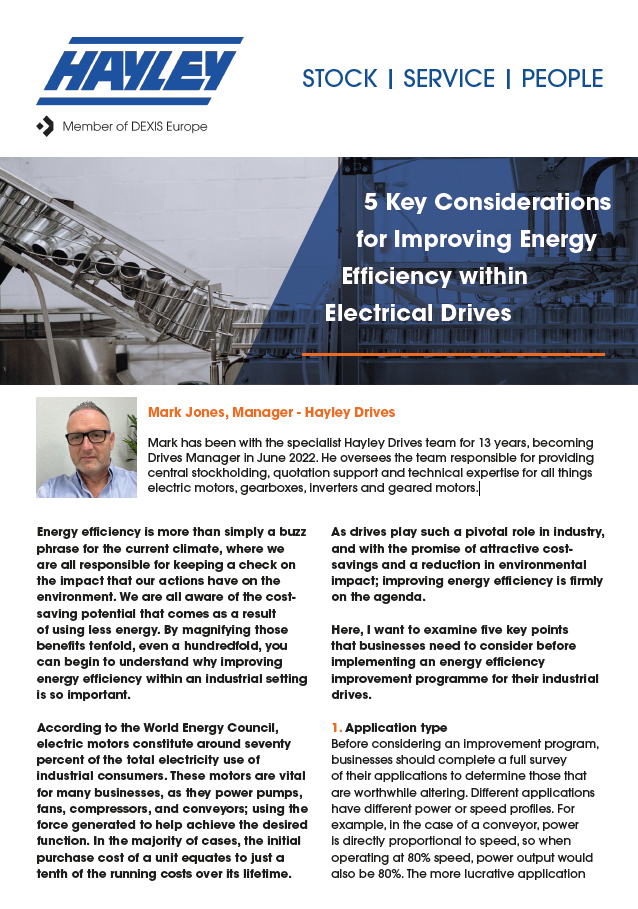Mark Jones, Manager - Hayley Drives
Mark has been with the specialist Hayley Drives team for 13 years, becoming Drives Manager in June 2022. He oversees the team responsible for providing central stockholding, quotation support and technical expertise for all things electric motors, gearboxes, inverters and geared motors.
Energy efficiency is more than simply a buzz phrase for the current climate, where we are all responsible for keeping a check on the impact that our day-to-day actions are having on the environment. As individuals, we are all well aware of the cost-saving potential that comes as a result of using less energy. By magnifying those potential benefits tenfold, even a hundredfold, you can begin to understand why improving energy efficiency within an industrial setting is so important.
According to the World Energy Council, the powering of electric motors constitutes around seventy percent of the total electricity use of industrial consumers. These motors are vital for many businesses, as they power pumps, fans, compressors, and conveyors; using the force generated to help achieve the desired function. In the majority of cases, the initial purchase cost of a unit equates to just a tenth of the
running costs over its lifetime. As drives play such a pivotal role in industry, and with the promise of attractive cost-savings and a reduction in environmental impact; improving energy efficiency is, quite rightly, on the agenda of many.
Here, I want to examine five key points that businesses need to consider before implementing an energy efficiency improvement program for their industrial drives.
1. Application type
Before considering an improvement program, businesses should complete a full survey of their drive applications to determine the type of applications that are worthwhile altering. Different applications have different power or speed profiles. For example, in the case of a conveyor, power is directly proportional to speed, so when operating at 80% speed, power output would also be 80%. The more lucrative application types, such as centrifugal fans or pumps, have a power output proportional to speed cubed. This means that at 80% speed, power output would be approximately 51%. Understanding these application types is fundamental to appreciating the potential to save energy through control.
2. Methods of control
The second question to raise when looking to implement an energy-savings program is; how does each application need to perform? In the case of a conveyor or crusher, an AC induction motor is most likely required to run permanently at a fixed and stable speed. The motor needs to be constantly running in such applications, and any downtime for maintenance is only performed when necessary, to minimise lost production and revenue. If the demand on the speed of the application fluctuates (e.g. for a cooling fan), then using variable speed control becomes a viable energy-saving option. By fully understanding the demands on the application, businesses can make more informed decisions.
3. Running time
Thirdly, businesses need to consider the running time of each of their drive applications. Industrial users of motors benefit from knowing the durations of operational activity and the frequency of demand placed on each application. Understanding the length of time units are operational for, and how many times a restart is required after an idle period, is crucial to making an optimal return on investment in any energy efficiency-boosting technologies. Whilst some applications, like centrifugal fans, offer excellent energy-saving potential, the longer the motor runs, the quicker the ROI. Possible improvements made to an application that runs for one hour per week, every week, is rarely economically viable. Whereas, an application that runs 24/7, even with limited speed reductions, usually offers a speedy return with attractive cost-savings.
4. Motor size
The size and rating of the motor really matters when it comes to looking at implementing an energy-savings program. The percentage savings available from an application are relatively consistent, regardless of motor power. However, the actual impact on a company’s energy consumption, and therefore their electricity bill, is reflected in the possible financial gains to be made. This is clearly affected by the size of the individual motor or number of active motors contributing to the overall consumption level. Ultimately, company expectations influence the decision making here. Working on a single 1.5kW motor may not be cost-effective, but improvements to a 110kW motor or ten 11kW units would almost definitely yield positive results.
5. Current product specifications
The final of the initial considerations that businesses need to make when hoping to improve energy efficiency, surrounds the specifications of their existing motor(s), and how their drive train is connected. Older and rewound motors are less efficient by their very nature and are therefore capable of offering immediate cost-savings. Having said this, it is still important to factor-in motor size to determine viability.
The mechanical arrangement also needs to be considered. Many products form a complete drive train and the overall design specification needs to be reviewed to ensure optimum efficiency. For example, it would be prudent to replace a design containing older gearboxes, couplings, belts, etc. A setup such as this may have an overall efficiency as low as 55%, so an effective solution would be to replace with a newer, close coupled geared motor with a 90% efficiency.
At Hayley Group’s Drives division, we have the relationships with established manufacturers and the decades of combined staff expertise, to design complete solutions incorporating these technologies.



